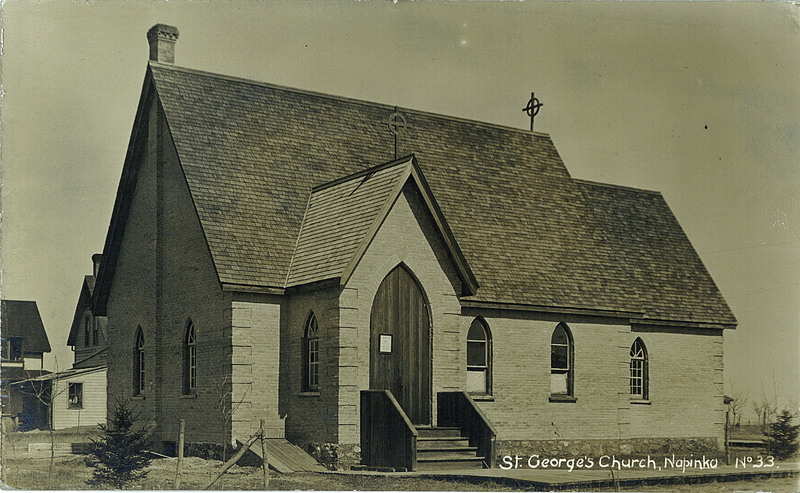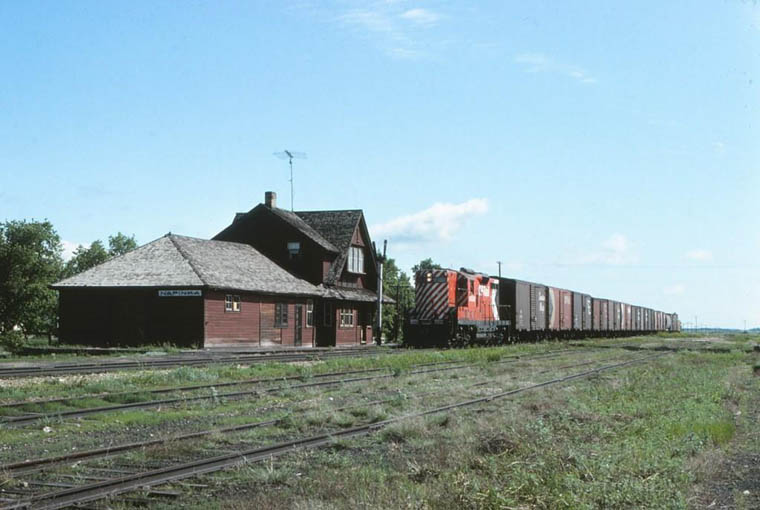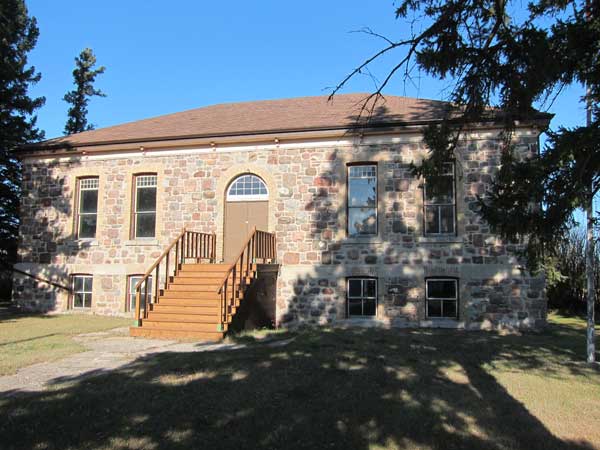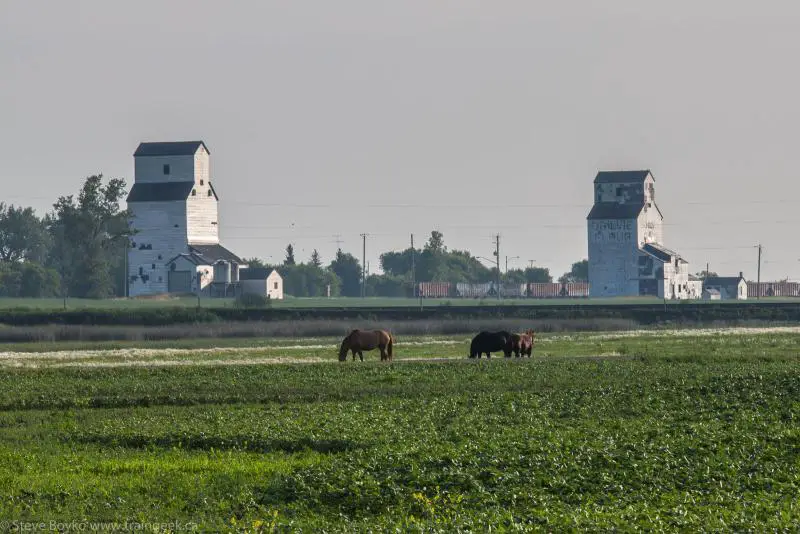Last Monday, August 24, 2015, my grandmother, Gladys Pearl Bugg, passed away. A kind, remarkable, woman fell asleep one last time. Born in 1931, married in 1951, and had five children, 10 grandchildren, 10 great-grandchildren, innumerable friends, and many fond memories.
In memory of her, I've decided to post this article, one I worked on for a local heritage group for a future history book, about the small town where our family grew up around, Napinka, Manitoba, Canada.
Note: unless otherwise stated, all the towns mentioned in this article are in Manitoba. Promise!
 |
| I really, really, really wish I had a better program for making maps. All that empty Northern space to point out, yes, this is Manitoba... |
The story of Napinka is one tied very
closely to that of the railroads in a way that no one alive today can fully
comprehend to this day of the car and airplane. Napinka seemed destined for a
time to become the most important town in the region when the first settlers
set up homes in 1881 and 1882 as the excitement of the railways grabbed hold of
the country. It would take until July 1891 and years of broken promises and
missed deadlines – even leading to the electoral defeat of a Member of the Manitoba Legislative Assembly (MLA) when he
promised the railroad by 1888 – before the Canadian Pacific Railway did lay the
tracks they promised to Napinka from Kemnay as part of the Estevan Subdivision, terminating in Estevan, Saskatchewan.
A year later, the line from Deloraine had been finished to Napinka, much to the
disappointment and anger of Melita, who sent a delegation to Winnipeg to argue
for the junction of the rail lines in Melita to no avail.
The next sixty years where the heyday of
Napinka. Trains came in every day from Brandon, Winnipeg, Estevan and the many
small towns along the line. To service the trains, the CRP built a water tower
pumped from behind a dam the railway built on the Souris River, with a ball on
top that would let people see how much water was available. A coal dock, tool
shop, round house (found to be too small when originally built) and bunkhouse
were also built to serve the CPR in Napinka. The passengers and crew on the
trips that stopped overnight in Napinka used the hotels and stores built along
Railway Avenue. In 1892, an article in the Brandon
Sun mentioned Napinka having “…two general stores, three hardware stores,
two butcher shops, one flour and feed store, one watchmaker, two dressmakers,
builders, coal and wood dealers, one elevator, two lumber yards, a drug store
and a barber shop…” Boarding houses, two hotels including the infamous Leland
and the Russell, two banks, a blacksmith, doctors, a laundry operated by a
Chinese immigrant, a Massey-Harris dealership, and eventually, with the arrival
of the automobile, two garages were also set up in Napinka after this article
was written.
 |
| Main Street, Napinka. Though, it's not actually called "Main Street," it's Railway Avenue. Because the CPR loves pointing out how important they are. |
A beautiful two story stone school house,
built from 1897 to 1900 and constructed of stone hauled from south of the
present Highway #3, is an example of the pride and feeling of prosperity that
grabbed hold of Napinka. On May 28, 1908, Napinka was officially incorporated
as a village, with a population of nearly 400.
Sports teams, social clubs, and women’s
organizations were set up in these early days, bringing amusement and community
to the inhabitants of the town. An open air skating and curling rink was built
in 1896, while a newer curling facility was built in 1906, and curlers from
Napinka achieved great success in bonspiels across Manitoba. Three churches,
the Zion Methodist, Presbyterian, and Anglican churches were in Napinka at the
turn of the century, though the Methodist and Presbyterian would unite to form
the United Church in 1917, nine years before the United Church was formed
nationally. The Napinka Women’s Institute was established in 1921 and a Red
Cross branch was set up in 1941. The Faith Rebekah Lodge was set up in Napinka
in 1947, while a Beef and Home-Ec 4-H club were only set up in the 1960s, along
with the Napinka Explorers and a Canadian Girls in Training (C.G.I.T.) branch affiliated
with some of the churches in town.
 |
| Out of the three churches, only this one is still standing... so I guess it wins the "Still Standing Prize?" |
The ambitious residents, when the need for
a baker became apparent, decided they wanted something grander and offered
$5000 for someone to set up a gist mill, which was a sign of progress in small
towns across Western Canada at the time. Although land was set-aside just
outside of town, no gist mill was ever built.
Even during the hard years of the World
Wars and the Great Depression, Napinka continued to thrive, mostly thanks to
the railway. For a few years after the young men returned from Europe in 1945,
things looked like they would continue. A new community hall that is still
active to this day was built in 1946, while a skating rink was erected in 1953.
However, two incidents in the 1950s sounded
the death knell of the town. On March 6, 1951, a fire destroyed the Russell
Hotel and, possibly more importantly, it’s beer parlor, damaging business in the town. Even more
devastating, the use of the Diesel engine in trains, and the rapid
“dieselization” of the CPR fleet starting in 1957 lead to the end of the
classic days of steam trains. Declining passenger and freight revenue on these
same trains as the personal automobile and the grain truck took over previous
duties that the train did so well resulted in many of the routes being suspended
in the late 1950s and early 1960s. The water tower and coal dock were torn down
in 1963, while the station remained just long enough to be used for filming in
the 1985 NFB film Daughters of the Country – Part III, Places Not Our Own, but was moved soon after to a place
near Shilo, and turned into a personal home.
 |
| Someday, I really, really, really want to get that train station back. If just so I can dress up and look at my pocket watch worriedly and shout at people. |
Businesses that were long staples of
Napinka began to disappear: the Blacksmith closed its doors in 1957, the two-story
building being divided: the top half that was used as the church, school and dancing
in the early years, was taken off and was sent to Virden, the bottom to be used
as a cattle shed. The Co-op left in 1962, while the last butcher closed in
1961, the building being used as the Legion in Napinka for many years, until it
was moved. The poolroom and barbershop where closed in 1962, with the building
torn down 14 years later. Two elevators out four at the height of Napinka
remain along the tracks, but were closed by 1984, and are currently owned by
Tilbury Farms from Melita. The Village of Napinka itself voted itself out of
existence on January 1, 1986, all duties being taken over by the Rural
Municipality of Brenda. At this time, only 132 people called Napinka home. One
of the last things the Village of Napinka did before it ended was install water
and sewer lines for the village.
The school, long a source of pride, was
also shut down. Though an addition had been built in 1959-60 that added more
classrooms, a library and indoor plumbing, consolidation of the rural schools
lead to the closing of the high school in 1968, and later the last elementary
classes were ended in 1975 with all students being bused to Melita. The old
stone building is now empty, while the newer addition was turned into the
Drop-in-Center, providing a place for coffee in the mornings, a small library
to serve the community, and for family and community events.
 |
| This is a very impressive building when you look at it up close. Take my word for it. |
The skating rink fell down in 1996, and was
never rebuilt; the curling club had ended in 1973, and it’s building torn down
in 1977. Green’s Garage, the only business in Napinka to be held by the same
family for it’s entire existence, finally closed its doors for good in the
1990s. The old two-story brick post office, formerly the Bank of Montreal when
it was first built, was torn down in 2010, though for many years Bodkin’s
Grocery Store was Napinka’s post office, but eventually it too closed in 1990
and now only a lonely row of community mailboxes is all that is needed. One of
the last remnants of Napinka, an old Livery barn, was only taken down in 2013
and the Zion United Church was demolished a few weeks before this article was
written in 2014. The Anglican Church had been purchased years before for
personal use by a resident in Napinka.
The story of Napinka isn’t one that is
unique: every small town in Western Canada has faced this problem of
depopulation and a lack of purpose in the era of cars and airplanes. While some
managed to survive, many others have died out and are now nothing more than tiny
dots on a map. In a town that once held so much promise and ambition, Napinka
still holds on to the past; the old fire hall with two horse drawn fire wagons
can still be looked at, while the school house still stands on a beautiful lot
of trees and flowers. Trains still rumble through Napinka, though they are now most
likely carrying grain, coal and even oil. Though in the end this is a sad
story, the memories of the glory days of the early twentieth century is still
strong in the residents of the town who remember the magic of a steam train
sliding in gracefully next to the station on a puff of white smoke and dozens
of people disembarking to take in the charm and vitality of a small town with
so much promise.
Throughout the early years of Napinka, the
trains brought in some people that have since become famous;
-J. S. Woodsworth: First leader of federal
Co-operative Commonwealth Federation (CCF, later NDP, 1932-42), leader of
Winnipeg General Strike 1919 - Methodist Minister in 1897.
-Seymour J. Farmer: Mayor of Winnipeg
(1923-24), City Councillor (1928-29) Leader of Manitoba Co-operative
Commonwealth Federation (CCF, later NDP), MLA from 1922-1949 – C.P.R. clerk
-Poet and performer Pauline Johnson, c.1908
Sources: Brenda History Committee. Bridging Brenda Volume I. Altona,
Manitoba; Friesen Printers, 1990. Page 286-293

The death of small towns like Napinka to some spelled progress and to others the death of a dream they shared with family and friend.It bothers me when i see such promise swept away by time as society changed the future of humanity by racing forward toward a disturbing future. Blessing to Napinka and all other once thriving communities who have lost out to the future. Lost somewhere in the past where life was a much slower pace and joy filled the hearts of the townsfolk. These small towns are vanishing but they will alway be remembered in the hearts of those who were able to call them home and live a laid back lifestyle deserted over 50 years ago.
ReplyDeleteThanks for this! I've linked your page to one I'm working on about a former resident - Alexander Kippen Cates at my blog here. https://ssimms644.blogspot.com/
ReplyDeleteLove this My family is also from there, Bill and Rosa Yeomans.
ReplyDeleteI also grew up there. I learned to curl there, even curled on a winning team one year. Better to grow up in a small town, learning how to do life skills. Miss that little town.
ReplyDeletegreat article. loved reading all about the past. used to live and grew up near Napinka. went to the school.
ReplyDelete